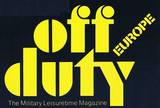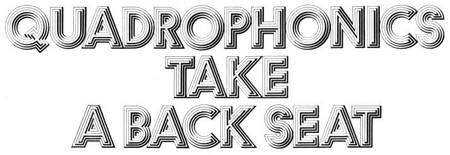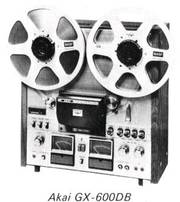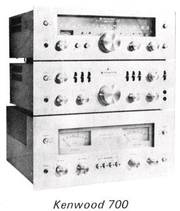"off duty" 1970 - 1997 - eine Freizeit-Zeitung für's US-Militär
Die in diesem amerikanischen (Freizeit-) Shopping-Magazin angepriesenen Hifi- und Video-Produkte waren auschließlich amerikanischen und kanadischen Militärangehörigen zugänglich - also zu kaufen - und vor allem zu ganz ungewöhnlich (verblüffend) niedrigen US $ Military-Preisen. Zu der einführenden "off duty" Seite geht es hier lang. - Um 1970 begann der weltweite Hifi-Boom bis zum 1. Crash 1978 und dann wieder zum 2.Crash um 1990. Über die 20 Jahre nach 2001 lesen Sie mehr in den Kolumnen auf diesen japanischen Seiten.
.
QUADROPHONICS TAKE A BACK SEAT
What was In and what was Out at this summer's Consumer Electronics Show - By WALTER B. RIOS - OffDuty / Europe / August 1974 - Teil 1
.
"WHAT'S HAPPENED to 4-channel?"
Making the rounds of the audio industry's giant exhibit at McCormick Place on Chicago's lakefront, we heard the 4-channel question repeatedly from visitors started to find quadrophonics taking a back seat. At this year's Summer Consumer Electronics Show (CES), much of the excitement is in tape. And, would you believe, stereo? The two-channel medium is alive and well and not about to play dead, despite the advent of Surround Sound.
Mind you, quadraphonics are here to stay. But, despite four years of promotional hoopla and energetic R&D by equipment designers, the new medium still accounts for less than 20 per cent of the Stateside audio market. Even staunch supporters ruefully concede that 4-channel's growth rate is likely to remain slow until the Federal Communications Commission (FCC) approves a broadcast standard. When it comes, they insist, the rush will be on, in much the same way stereo took over when the FCC gave FM multiplex the green light in the Sixties. But FCC approval may still be a couple of years away.
.
Es hapert immer noch an "needed software"
Meanwhile, the recording companies are contributing to the 4-channel doldrums with their slow pace in releasing needed "software". They offer numerous excuses. Top-quality vinyl is in short supply. Cutting a 4-channel disc takes much longer than stereo. Recording technology must be refined, new equipment added. Not to mention the uncertainty over systems - SQ, QS and CD-4 - that discourages record producers from making a firm commitment. Unlike equipment manufacturers, eager to get a technological jump on competition, the record companies are in no hurry. So, until an FCC ruling opens the 4-channel floodgates, most of their new releases will likely remain in conventional stereo.
Recognizing that 4-channel, instead of blitzing the competition as predicted, is in for a long campaign, equipment manufacturers are now giving special attention to the stereo components that still comprise their bread-and-butter business. Some of CES' highest-priced and most feature-packed new products are in stereo, which suddenly finds itself in the promotional limelight once again.
Und "4-channel broadcasting" gibts auch noch nicht
The absence of 4-channel broadcasting, and the limited software thus far available, means that most music listening will be in stereo for some time to come. So there's renewed emphasis in derived 4-channel, such as the sound field produced with the synthesizer in Sansui's QS Vario-Matrix. Consisting of three ICs and an FET, this new third-generation decoder handles both QS and SQ.
Its designers claim to have achieved a "square" sound field with 20 dB separation in each corner by employing a new type of logic circuitry. Play stereo through the system, says Sansui, and the synthesizer divides the two signals into four distinct channels. So, if the real thing is a little slow in coming to your nearby Exchange record department, you can synthesize your own Surround Sound. Ma-rantz, too, offers a Vario-Matrix synthesizer in its latest 4-channel receivers.
.
Versprechungen und Versprechungen
Ironically, what's really new in 4-channel this year is that manufacturers are catching up with their delivery promises. After
a long delay caused by late delivery of needed "chips" from suppliers of semiconductors, there's a full range of all-systems receivers available, with CD-4 as well as matrix circuitry built in to handle the three types of quadraphonic recordings. Among the new entries are Fisher's model 634 with full logic SQ circuitry as well as a CD-4 demodulator, and JVC's 4VR-5426X with all-IC demodulator, reportedly the first 4-channel receiver to feature CD-4 in chip form.
The stereo news at CES is for audiophiles who, sidestepping the 4-channel dilemma, prefer to go all out with just two channels. No longer is super stereo the private domain of specialized manufacturers making jumbo amplifiers while the big names concentrate on 4-channel development.
Es geht weg von Receivern zu sogenannten "separates"
All along the line, stereo components are being upgraded and much more attention given to "separates" - the individual preamplifiers, power amplifiers and tuners so dear to audio connoisseurs.
Kenwood's 700 series, typical of the new direction stereo is taking, was almost put in the shade at CES by its own engineers, who unveiled prototypes of even fancier units that will command out-of-sight prices if they see production. How about a crystal controlled, frequency synthesized digital tuner with automatic search and memory selector?
Still another Kenwood prototype is a power amplifier design featuring Field Effect Transistors that have, according to the engineers, many characteristics of a triode and thus produce a warmer sound than transistor designs. More like tubes. (Remember tubes?)
.
UKW (FM) und Dolby in den USA
Dolby again made news at CES, this time courtesy of the FCC, which recently gave FM stations the go-ahead to Dolby-ize their signal in combination with a reduction in pre-emphasis from 75 to 25 microseconds. Tuners with conventional 75-microsecond de-emphasis will not be made obsolete by this change, as the signal received will sound normal (while a Dolby-ized signal transmitted without reduction in pre-emphasis would sound too bright). For listeners with Dolby noise reduction equipment there is enormous advantage - a stronger, cleaner signal - provided they switch to 25-micro-second de-emphasis for reception of Dolby FM broadcasts.
Marantz schaffte Fakten mit eingebautem FM-DOLBY
Marantz, incidentally, anticipated the FCC ruling and built Dolby noise reduction circuitry into several new components, including the 4400 4-channel receiver, 2325 stereo receiver, and the 3800 stereo preamplifier control console. If you have Dolby circuitry in your cassette deck, or own an outboard Dolby adapter, it is suitable for Dolby FM provided the decoder has an FM-copy circuit. It's included in several top-of-the-line cassette tape decks, and Technics' new RS-676US also has the 25-micro-second provision. On other cassette machines with FM-copy circuits, a de-emphasis switch can be added by wiring in one resistor and one capacitor per channel. Details on the conversion are available from Dolby Labs, 1133 Avenue of the Americas, New York, NY 10036.
Bei den CC-Kassetten kommt der "vertical look"
The cassette story at CES is a radical change in styling. Some new models feature the "vertical look" typical of open-reel. It started last year with the introduction in audiophile circles of the Nakamichi 1000, a 3-head cassette machine priced Stateside at $1,100. Now Teac unveils the 850 with three heads and three motors, while Akai counters with the lower-cost GX-510D with two heads and one motor. What they all have in common is upright styling, definitely a trend.
They'll compete with other new cassette machines featuring the "component look" - Technics' RS-676US, Sony's TC-203SD and Pioneer's CT-F71 71. Each is styled to match its manufacturer's line of receivers, amplifiers and tuners, so it can be stacked with the components or placed alongside. All controls are on the front and loading of the deck is via a front-panel slot or window. The "console look" with controls on a sloped top panel is still in evidence, for it's a tried-and-true design.
Ganz neu : CC-Recorder mit 3 Köpfen
This year there are new models with three heads, while others offer bidirectional capability. The styling competition is in marked contrast to a year ago, when almost anybody's cassette deck looked like everybody else's.
Ein "Comeback" der großen Spulenbandgeräte
Open-reel tape, meanwhile, is making a big comeback, with a trend to 10 1/2" reels. Today's open-reel customer, say manufacturers, is a genuine hobbyist and demands the features of a recording studio.
What's more, he's willing to pay the price. Pioneer now offers him a 3-motor, 3-head 10 1/2" reel deck, model RT-1011L, priced Stateside in the $600 class. Tandberg, too, goes the 10 1/2" reel route with the new 10XD, which combines Crossfield Head circuitry with Dolby noise reduction to achieve a signal-to-noise ratio of 77 dB in two-track stereo (or 75 dB in four-track stereo). Tentative Stateside price is $1,150.
Teac's latest 10 1/2" reel model, the 7300, will cost $1,350 Stateside in the standard 4-track stereo configuration, but the same 7300 mechanism will be offered in a new 4-channel version with electronics contained in a separate carrying case. Called a "studio in a suitcase," it has eight sets of inputs that can be switched as needed to "line," "mike" or "tape," each with a separate slide control and self-synchronization circuitry for overdubbing and/or mixing on any or all of the four channels. Price is a cool $2,200.
Akai, meanwhile, offers two versions of its latest 10 1/2" reel deck, the GX-600D priced Stateside at $625, and the GX-600DB with built-in Dolby noise reduction at $725.
Neue Spulen-Bandmaterialien
With the surge of interest in 10 1/2" reel tape recording, look for more manufacturers to make their latest ferric-oxide formulations available on NAB reels. When TDK's big reefs reach the market, they will contain a new high-performance tape called Audua. The 3M people, meanwhile, offer a new line called "Classic" on 10 1/2" reels, in 2400-, 3600- and 4800-ft. lengths. The Classic name will be used on a complete range, including a new cassette tape with a two-layer formula combining ferric oxide and chromium dioxide. The thicker layer of ferric oxide gives this tape about 5dB more output than "chrome" at lower frequencies, according to 3M. The top layer of chromium dioxide (about one-fourth the total) adds the high-frequency boost characteristic of chrome tape, but doesn't require extra bias current, so the tape can be used on machines without a chrome switch.
If you wonder, by the way, why chromium dioxide isn't used on open-reel machines, the reason is that the formula's high-frequency output would be useless at recording speeds higher than 11 ips.
At the cassette's standard recording speed, however, this "hump" in chrome tape's frequency response falls nicely into the critical 8-20 kHz range and, with correct equalization, delivers superior high end performance. With tape grabbing so much of the spotlight, makers of record players had to come up with something new to attract attention, and they did. There are more new turntables of high quality than ever, and competition between high quality automatics and the single-play variety has never been fiercer.
Und der Dollar sinkt weiter ....
Prices, too, have risen sharply, partly because of the dollar revaluation but mostly because of the emphasis on top performance.
.
Auch bei den Plattenspielern tut sich viel
Customers who want their turntables to be ready for CD-4 gladly pay more for a quieter, wow- and flutter-free drive mechanism such as the costly new direct-drive models shown at CES by Dual, Technics, Kenwood, Sansui, Teac and Pioneer. All are single-play, incidentally, and dealers visiting CES report no lack of customer interest despite the absence of automatic features on most models.
But there are no cries of woe from makers of fancy changers, still enjoying a sales boom. Their number, too, has swelled with the entry of BIC (until recently Stateside distributor of England's Garrard), offering two record changers with belt drive, one of them with electronic speed control. (Das waren aber extrem bilige Teile)
Gleich mehrere Dutzend neue Lautsprecher
To the surprise of nobody, CES also provided a look-see at dozens of new loudspeakers, their makers delighting in the fact that to complete a quadraphonic system you need to buy four of them. Your concern as to where to place them - on an open shelf or against a wall or in a corner - is shared by designers, since placement critically affects the sound. So Acoustic Research has built a control panel into the front of its latest model, called the AR 77"/one. Its "woofer environmental control" offers a choice of three settings, and there are separate three-position level controls for the midrange driver and tweeter, permitting spectral balance to be adjusted depending on the speaker's position in the room.
Those are the highlights of the 1974 Summer CES, biggest audio show ever assembled under one roof.
There's more to come, in OFF DUTY'S stand-by-stand report to be completed in next month's issue.
.





